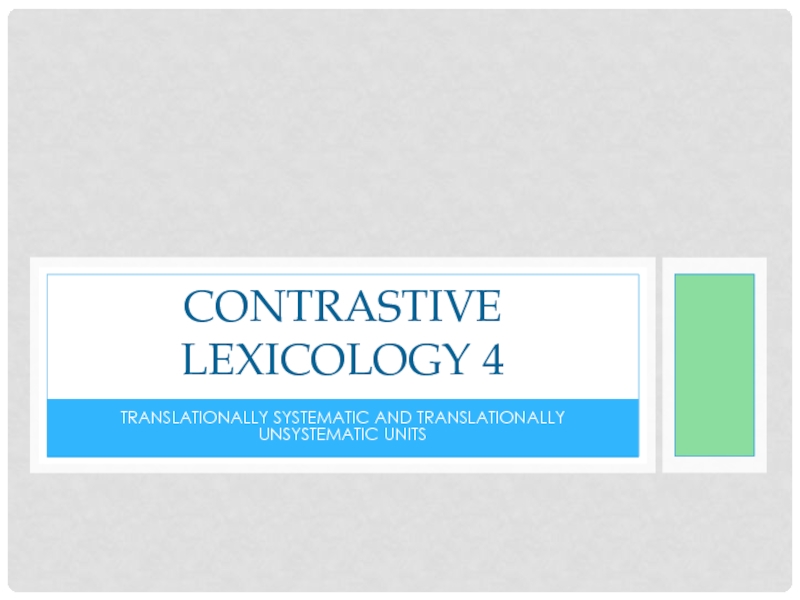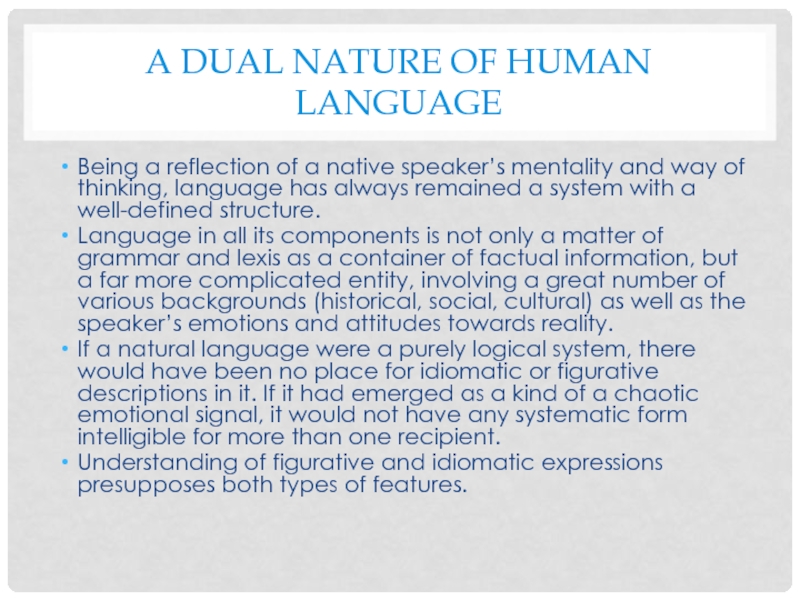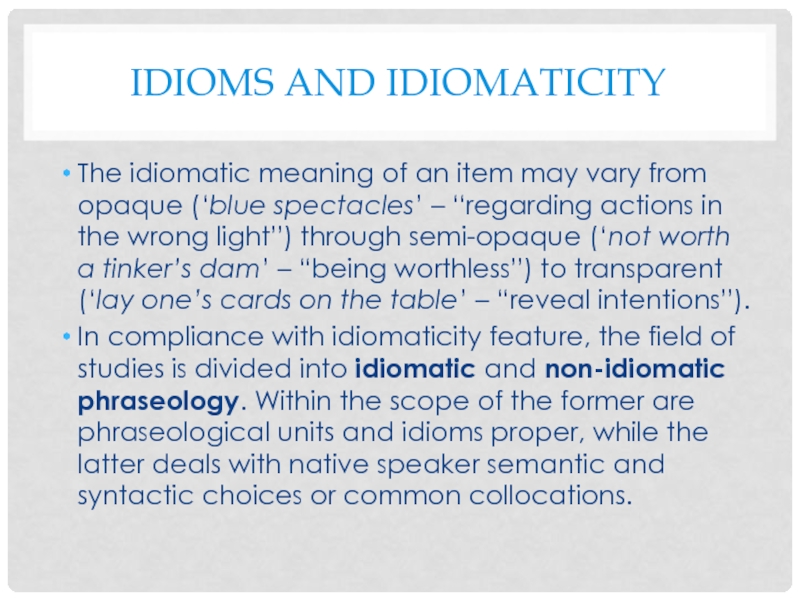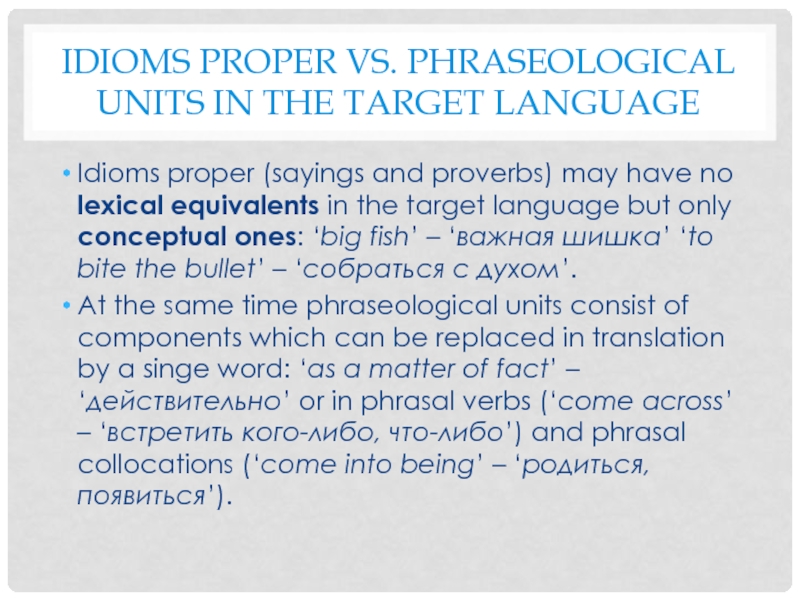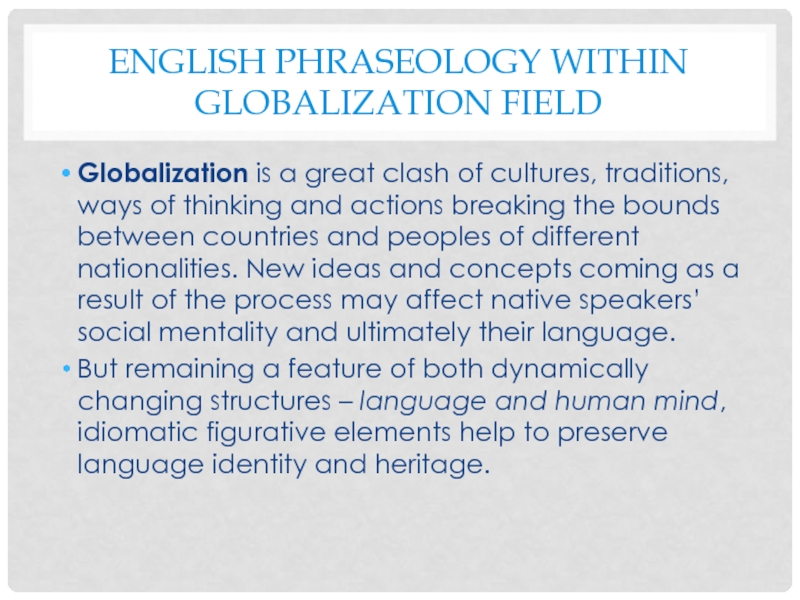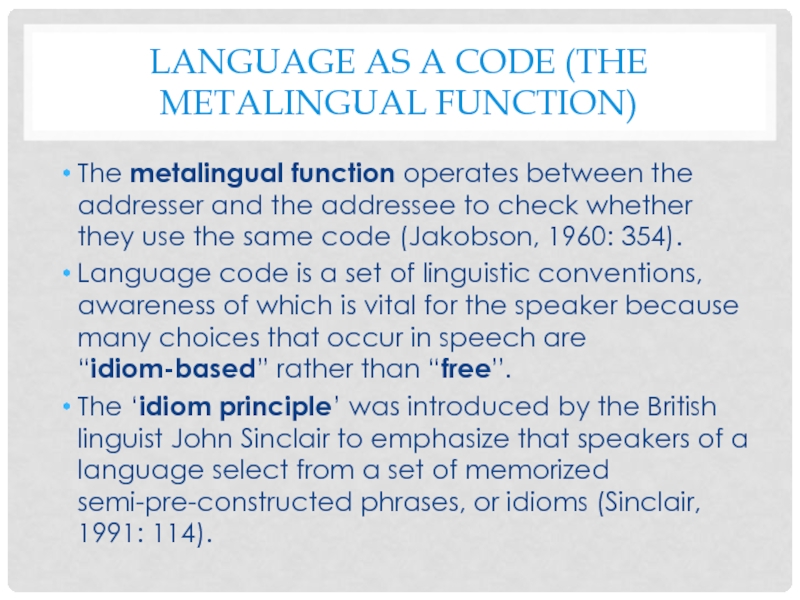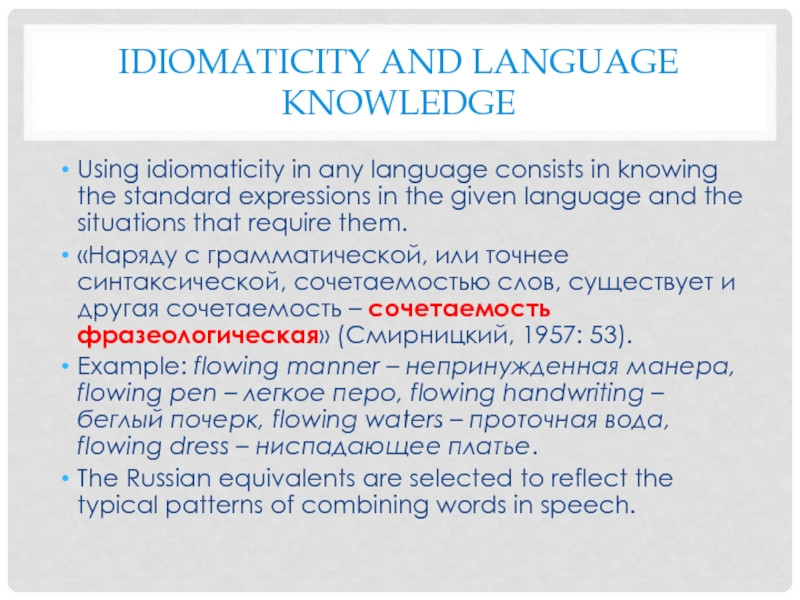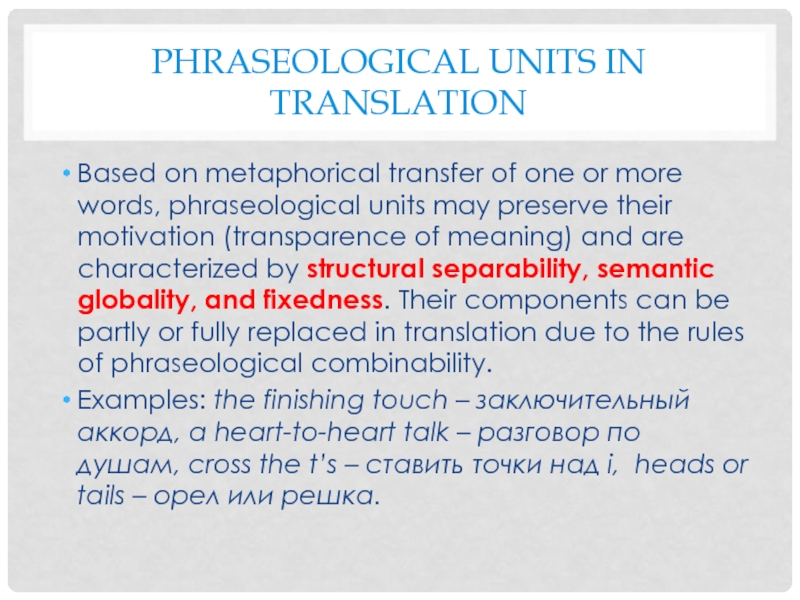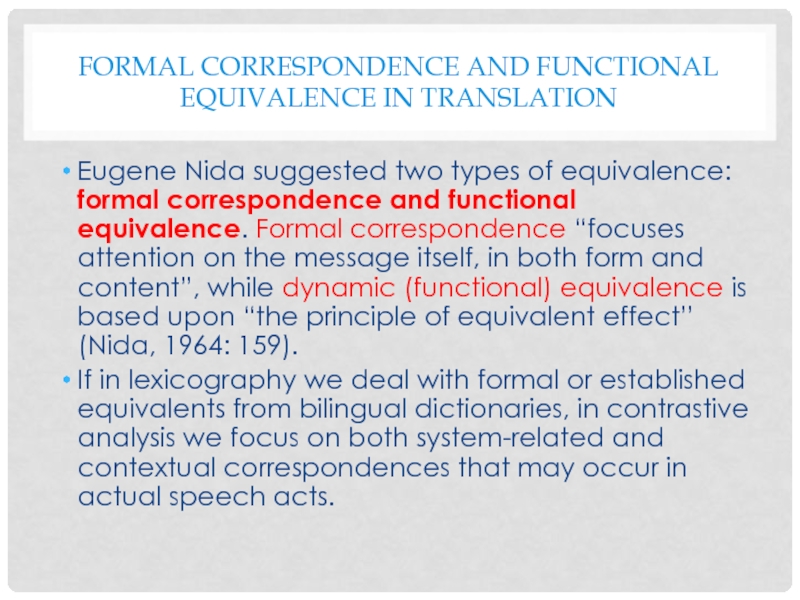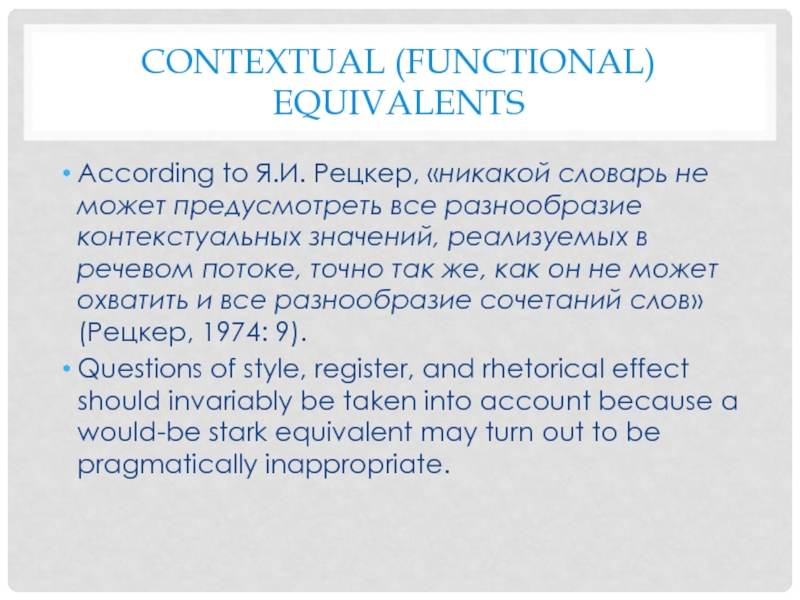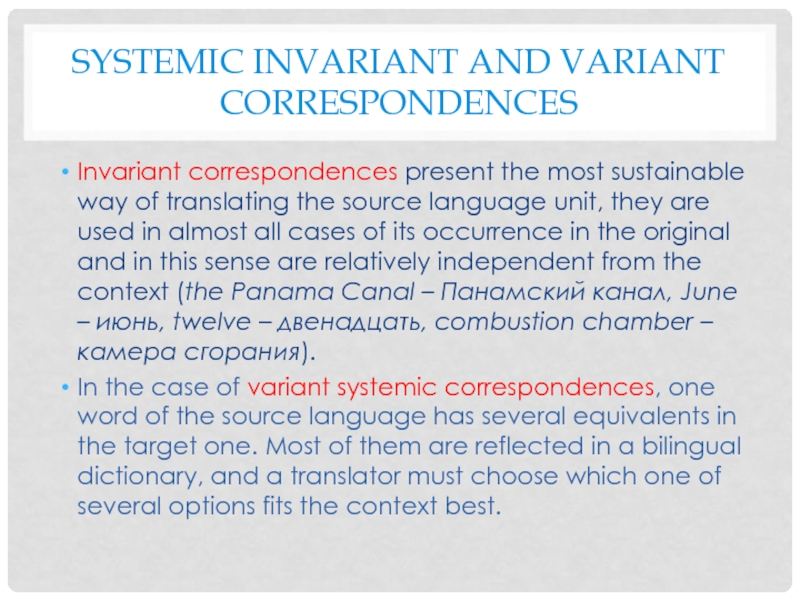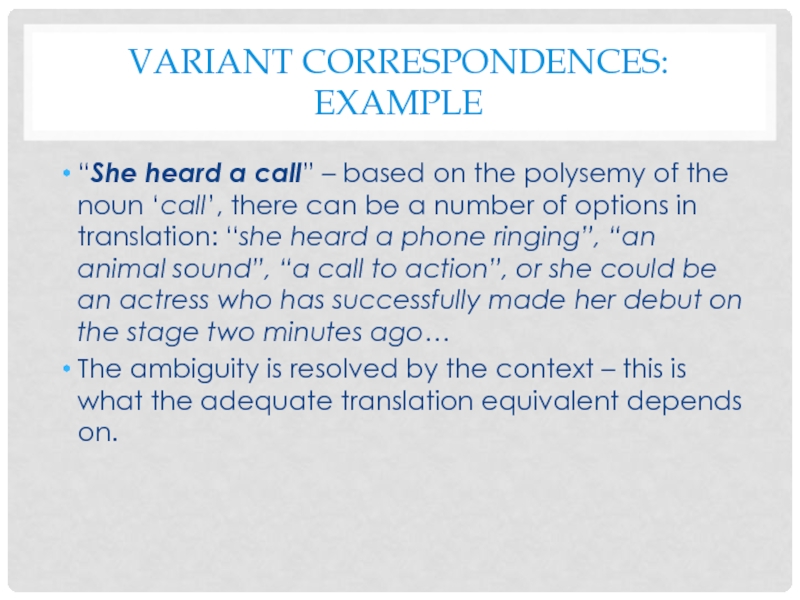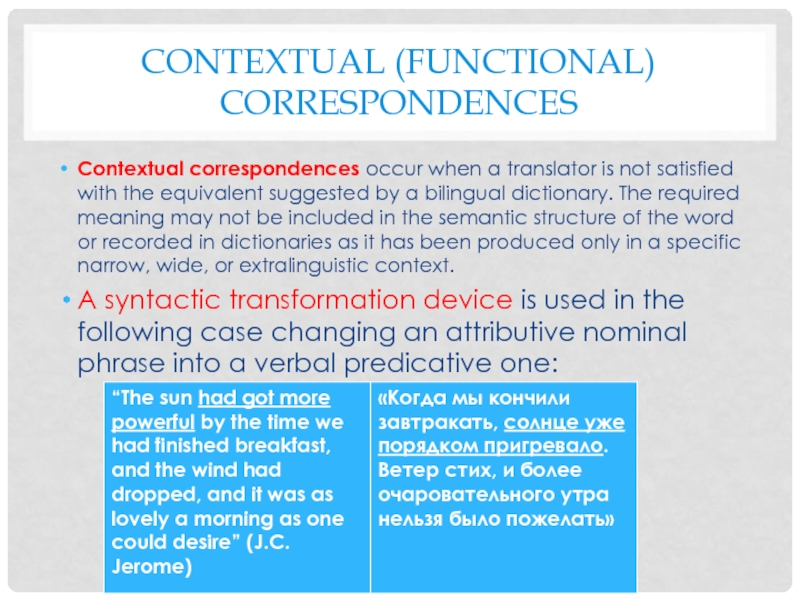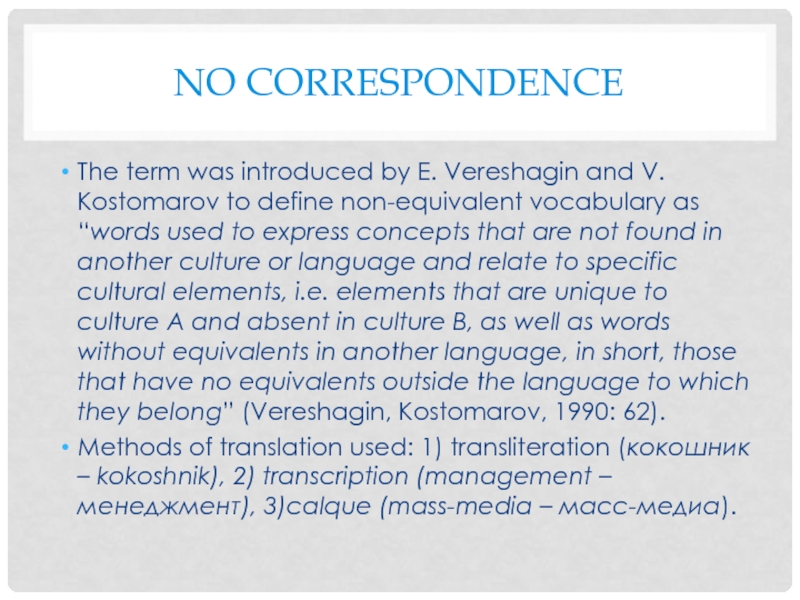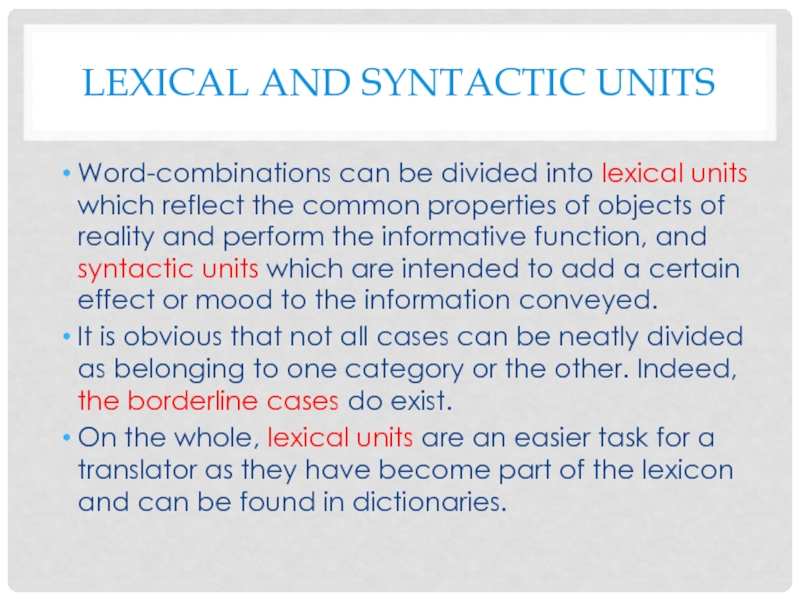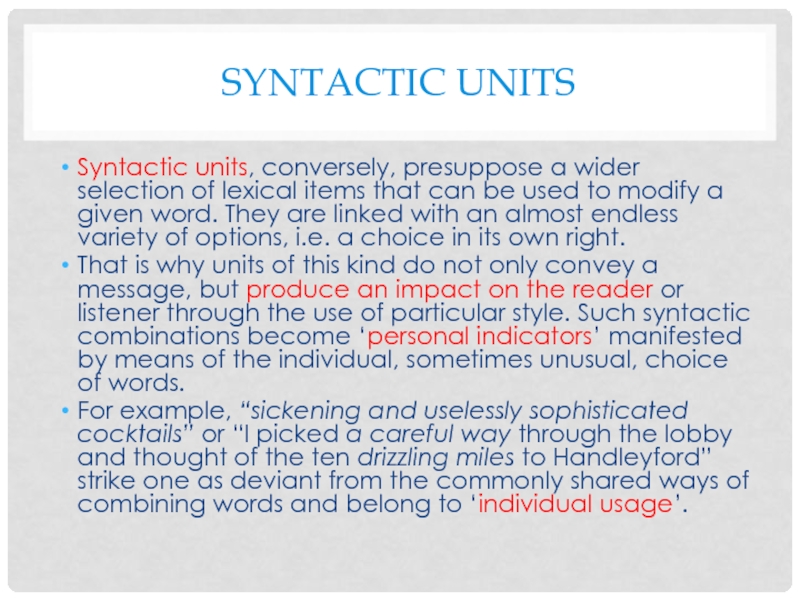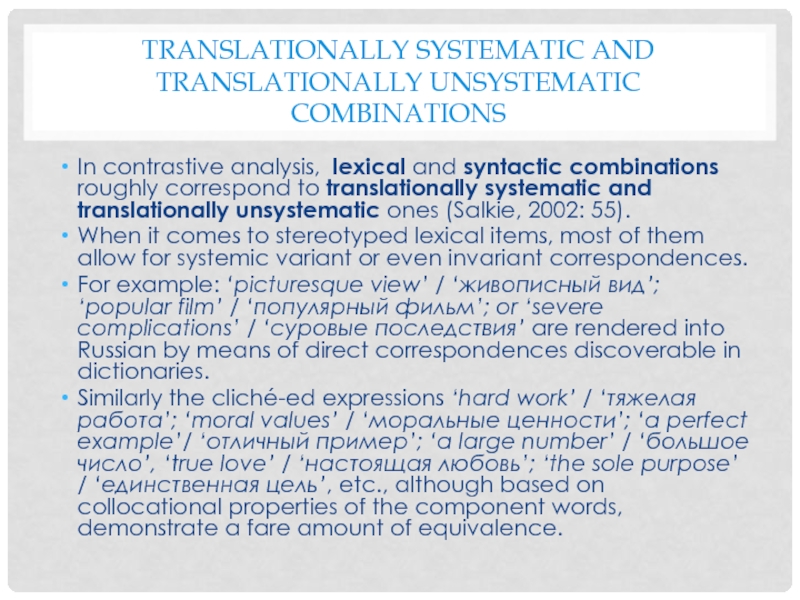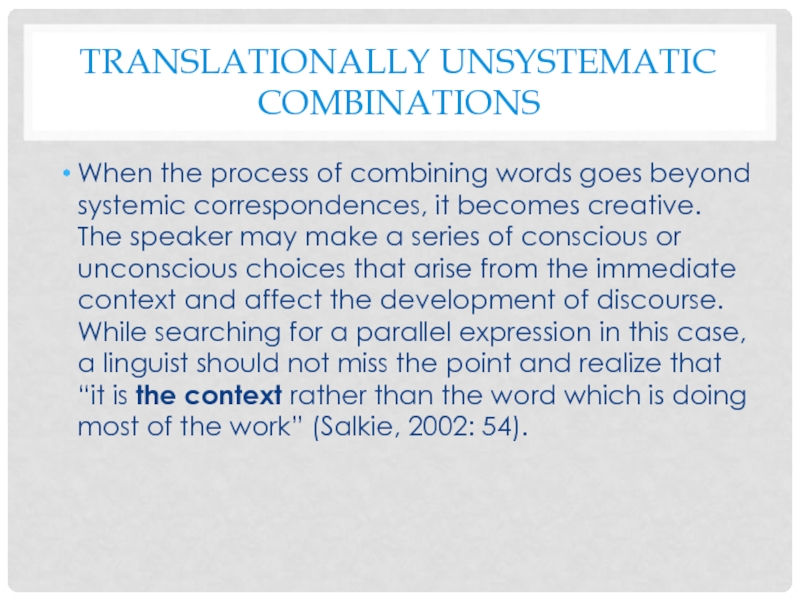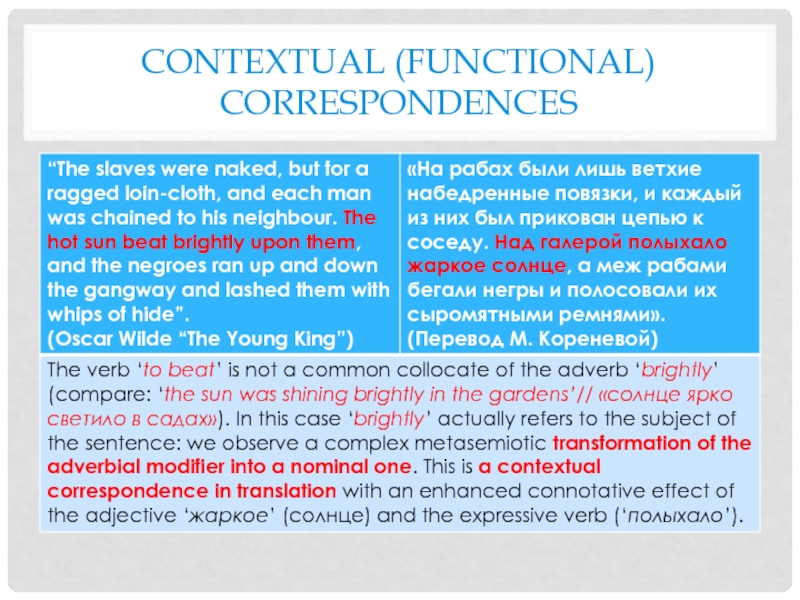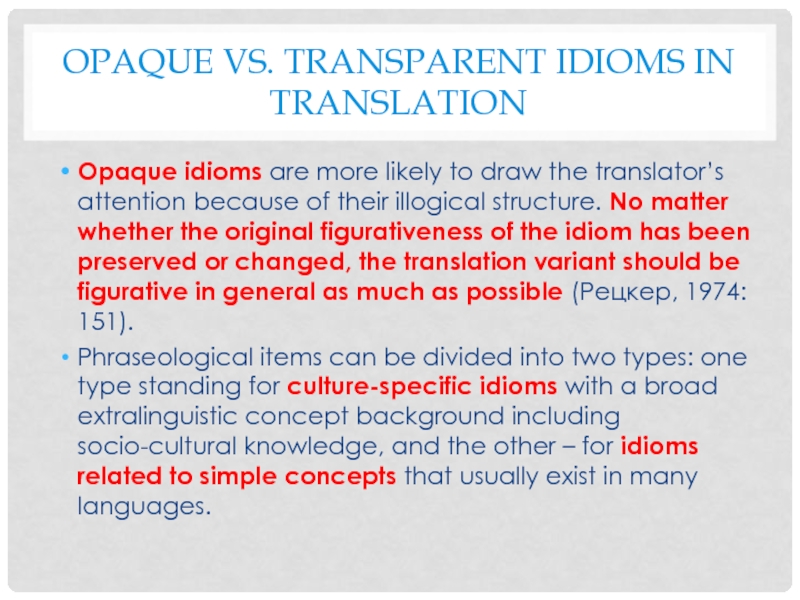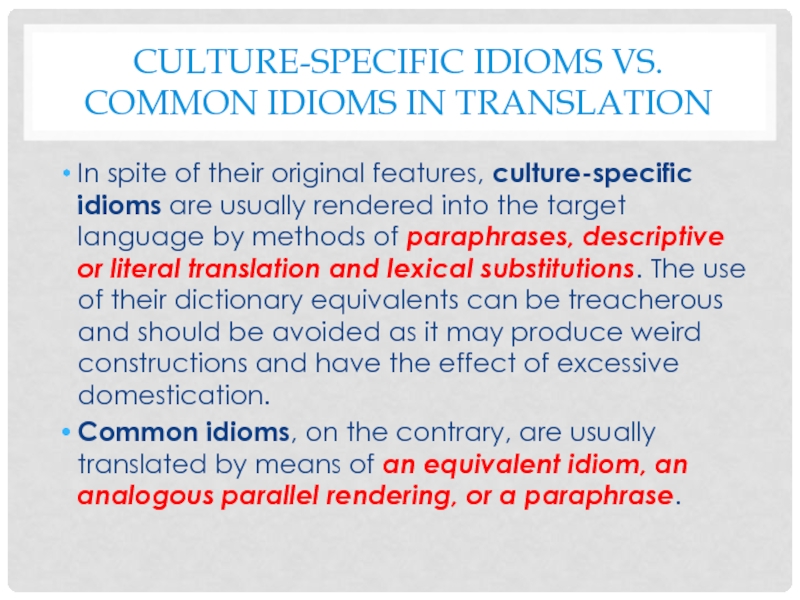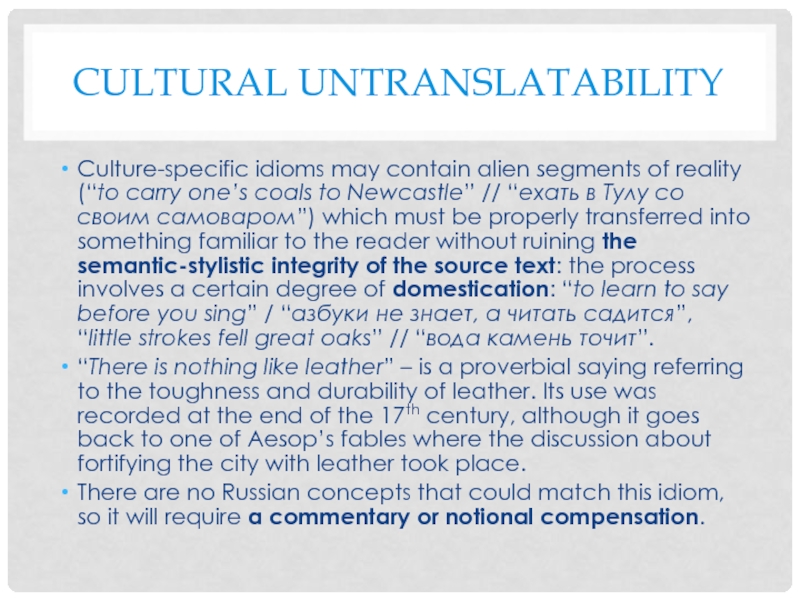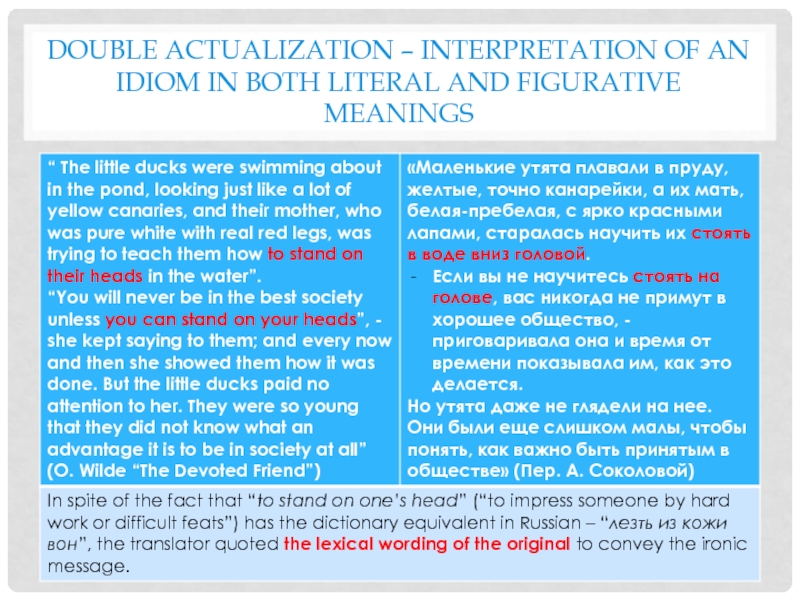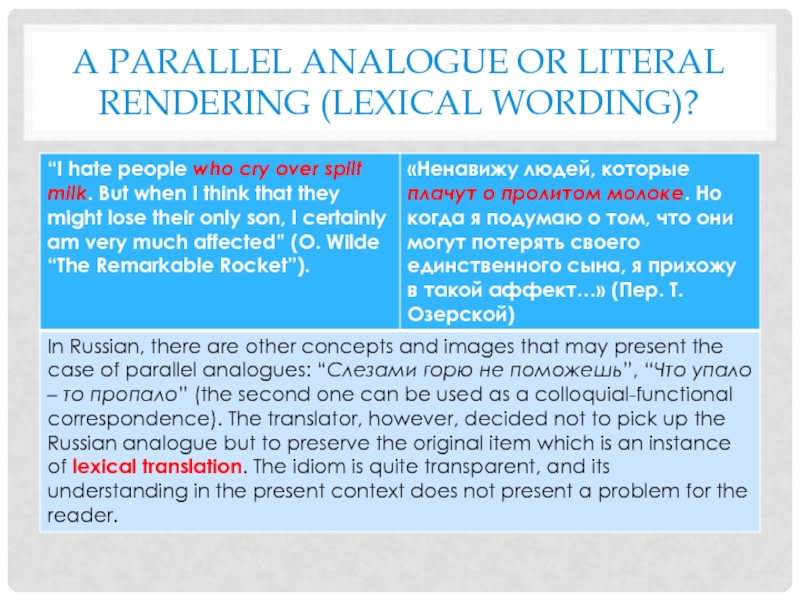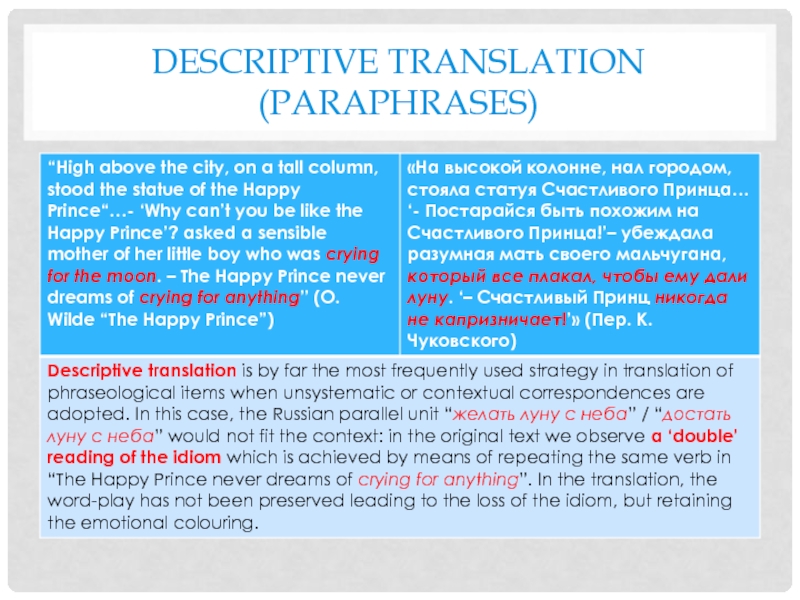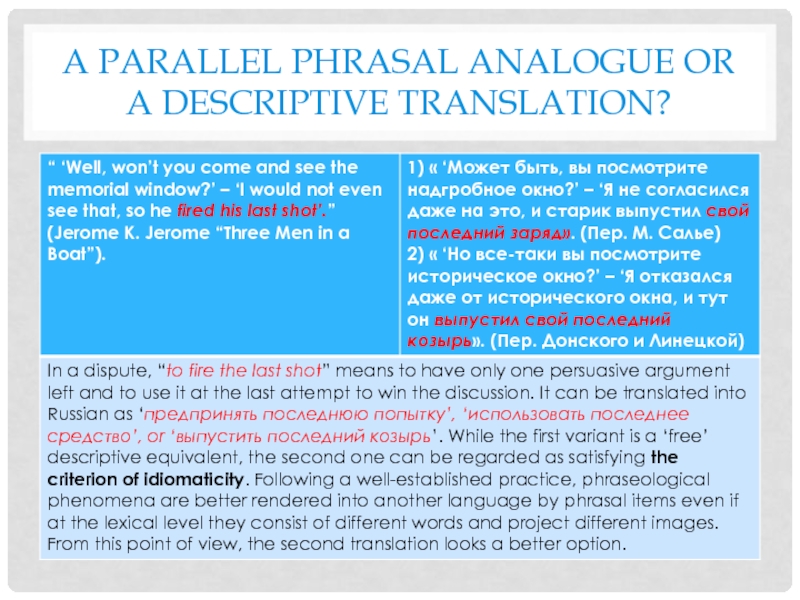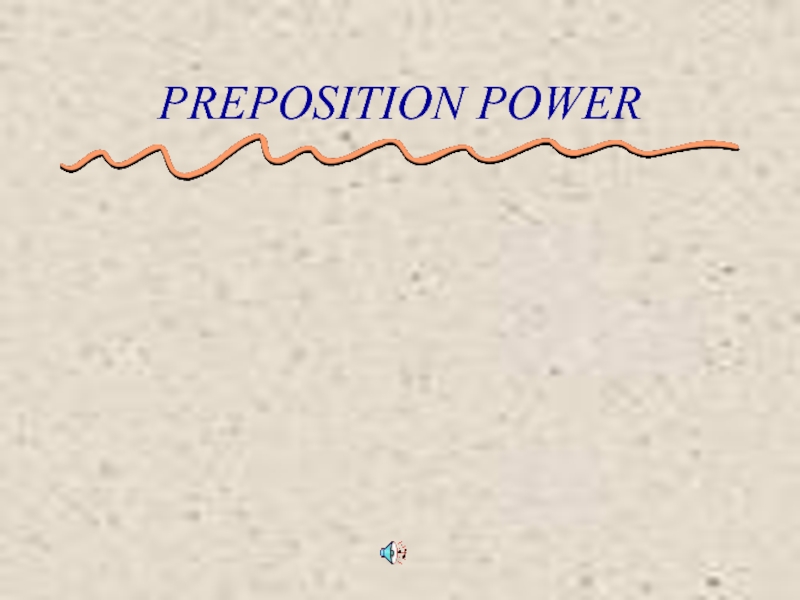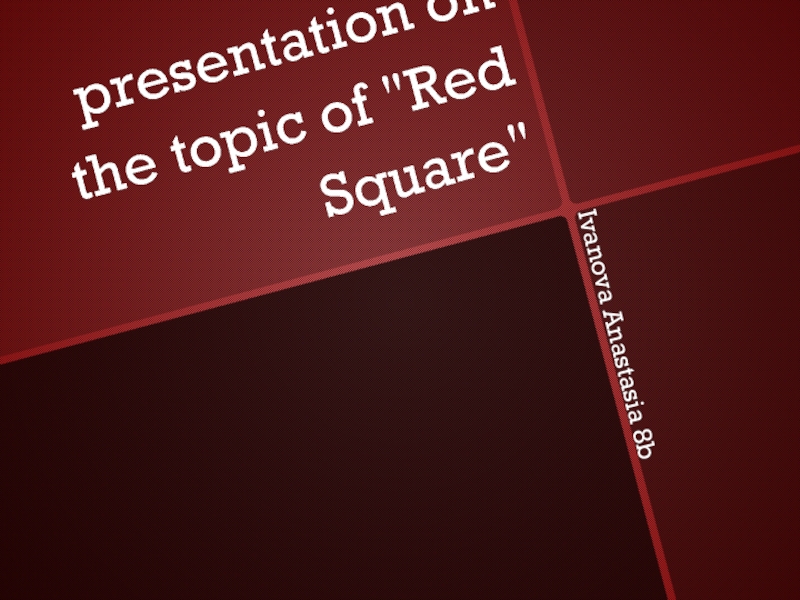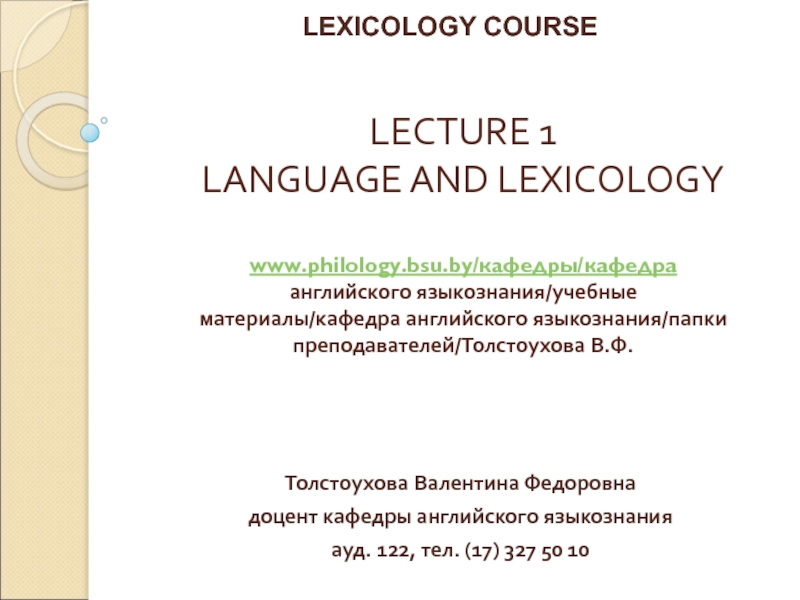- Главная
- Разное
- Дизайн
- Бизнес и предпринимательство
- Аналитика
- Образование
- Развлечения
- Красота и здоровье
- Финансы
- Государство
- Путешествия
- Спорт
- Недвижимость
- Армия
- Графика
- Культурология
- Еда и кулинария
- Лингвистика
- Английский язык
- Астрономия
- Алгебра
- Биология
- География
- Детские презентации
- Информатика
- История
- Литература
- Маркетинг
- Математика
- Медицина
- Менеджмент
- Музыка
- МХК
- Немецкий язык
- ОБЖ
- Обществознание
- Окружающий мир
- Педагогика
- Русский язык
- Технология
- Физика
- Философия
- Химия
- Шаблоны, картинки для презентаций
- Экология
- Экономика
- Юриспруденция
Contrastive lexicology 4. Translationally systematic and translationally unsystematic units презентация
Содержание
- 1. Contrastive lexicology 4. Translationally systematic and translationally unsystematic units
- 2. A DUAL NATURE OF HUMAN LANGUAGE Being
- 3. IDIOMS AND IDIOMATICITY The idiomatic meaning of
- 4. IDIOMS PROPER VS. PHRASEOLOGICAL UNITS IN THE
- 5. ENGLISH PHRASEOLOGY WITHIN GLOBALIZATION FIELD Globalization is
- 6. LANGUAGE AS A CODE (THE METALINGUAL FUNCTION)
- 7. IDIOMATICITY AND LANGUAGE KNOWLEDGE Using idiomaticity in
- 8. PHRASEOLOGICAL UNITS IN TRANSLATION Based on metaphorical
- 9. FORMAL CORRESPONDENCE AND FUNCTIONAL EQUIVALENCE IN TRANSLATION
- 10. CONTEXTUAL (FUNCTIONAL) EQUIVALENTS According to Я.И. Рецкер,
- 11. SYSTEMIC INVARIANT AND VARIANT CORRESPONDENCES Invariant correspondences
- 12. VARIANT CORRESPONDENCES: EXAMPLE “She heard a call”
- 13. CONTEXTUAL (FUNCTIONAL) CORRESPONDENCES Contextual correspondences occur when
- 14. NO CORRESPONDENCE The term was introduced by
- 15. LEXICAL AND SYNTACTIC UNITS Word-combinations can be
- 16. SYNTACTIC UNITS Syntactic units, conversely, presuppose a
- 17. TRANSLATIONALLY SYSTEMATIC AND TRANSLATIONALLY UNSYSTEMATIC COMBINATIONS
- 18. TRANSLATIONALLY UNSYSTEMATIC COMBINATIONS When the process of
- 19. SPEECH CLICHÉS IN FICTION
- 20. CONTEXTUAL (FUNCTIONAL) CORRESPONDENCES
- 21. OPAQUE VS. TRANSPARENT IDIOMS IN TRANSLATION Opaque
- 22. CULTURE-SPECIFIC IDIOMS VS. COMMON IDIOMS IN TRANSLATION
- 23. CULTURAL UNTRANSLATABILITY Culture-specific idioms may contain alien
- 24. DOUBLE ACTUALIZATION – INTERPRETATION OF AN IDIOM IN BOTH LITERAL AND FIGURATIVE MEANINGS
- 25. A PARALLEL ANALOGUE OR LITERAL RENDERING (LEXICAL WORDING)?
- 26. DESCRIPTIVE TRANSLATION (PARAPHRASES)
- 27. A PARALLEL PHRASAL ANALOGUE OR A DESCRIPTIVE TRANSLATION?
Слайд 2A DUAL NATURE OF HUMAN LANGUAGE
Being a reflection of a native
speaker’s mentality and way of thinking, language has always remained a system with a well-defined structure.
Language in all its components is not only a matter of grammar and lexis as a container of factual information, but a far more complicated entity, involving a great number of various backgrounds (historical, social, cultural) as well as the speaker’s emotions and attitudes towards reality.
If a natural language were a purely logical system, there would have been no place for idiomatic or figurative descriptions in it. If it had emerged as a kind of a chaotic emotional signal, it would not have any systematic form intelligible for more than one recipient.
Understanding of figurative and idiomatic expressions presupposes both types of features.
Language in all its components is not only a matter of grammar and lexis as a container of factual information, but a far more complicated entity, involving a great number of various backgrounds (historical, social, cultural) as well as the speaker’s emotions and attitudes towards reality.
If a natural language were a purely logical system, there would have been no place for idiomatic or figurative descriptions in it. If it had emerged as a kind of a chaotic emotional signal, it would not have any systematic form intelligible for more than one recipient.
Understanding of figurative and idiomatic expressions presupposes both types of features.
Слайд 3IDIOMS AND IDIOMATICITY
The idiomatic meaning of an item may vary from
opaque (‘blue spectacles’ – “regarding actions in the wrong light”) through semi-opaque (‘not worth a tinker’s dam’ – “being worthless”) to transparent (‘lay one’s cards on the table’ – “reveal intentions”).
In compliance with idiomaticity feature, the field of studies is divided into idiomatic and non-idiomatic phraseology. Within the scope of the former are phraseological units and idioms proper, while the latter deals with native speaker semantic and syntactic choices or common collocations.
In compliance with idiomaticity feature, the field of studies is divided into idiomatic and non-idiomatic phraseology. Within the scope of the former are phraseological units and idioms proper, while the latter deals with native speaker semantic and syntactic choices or common collocations.
Слайд 4IDIOMS PROPER VS. PHRASEOLOGICAL UNITS IN THE TARGET LANGUAGE
Idioms proper (sayings
and proverbs) may have no lexical equivalents in the target language but only conceptual ones: ‘big fish’ – ‘важная шишка’ ‘to bite the bullet’ – ‘собраться с духом’.
At the same time phraseological units consist of components which can be replaced in translation by a singe word: ‘as a matter of fact’ – ‘действительно’ or in phrasal verbs (‘come across’ – ‘встретить кого-либо, что-либо’) and phrasal collocations (‘come into being’ – ‘родиться, появиться’).
At the same time phraseological units consist of components which can be replaced in translation by a singe word: ‘as a matter of fact’ – ‘действительно’ or in phrasal verbs (‘come across’ – ‘встретить кого-либо, что-либо’) and phrasal collocations (‘come into being’ – ‘родиться, появиться’).
Слайд 5ENGLISH PHRASEOLOGY WITHIN GLOBALIZATION FIELD
Globalization is a great clash of cultures,
traditions, ways of thinking and actions breaking the bounds between countries and peoples of different nationalities. New ideas and concepts coming as a result of the process may affect native speakers’ social mentality and ultimately their language.
But remaining a feature of both dynamically changing structures – language and human mind, idiomatic figurative elements help to preserve language identity and heritage.
But remaining a feature of both dynamically changing structures – language and human mind, idiomatic figurative elements help to preserve language identity and heritage.
Слайд 6LANGUAGE AS A CODE (THE METALINGUAL FUNCTION)
The metalingual function operates between
the addresser and the addressee to check whether they use the same code (Jakobson, 1960: 354).
Language code is a set of linguistic conventions, awareness of which is vital for the speaker because many choices that occur in speech are “idiom-based” rather than “free”.
The ‘idiom principle’ was introduced by the British linguist John Sinclair to emphasize that speakers of a language select from a set of memorized semi-pre-constructed phrases, or idioms (Sinclair, 1991: 114).
Language code is a set of linguistic conventions, awareness of which is vital for the speaker because many choices that occur in speech are “idiom-based” rather than “free”.
The ‘idiom principle’ was introduced by the British linguist John Sinclair to emphasize that speakers of a language select from a set of memorized semi-pre-constructed phrases, or idioms (Sinclair, 1991: 114).
Слайд 7IDIOMATICITY AND LANGUAGE KNOWLEDGE
Using idiomaticity in any language consists in knowing
the standard expressions in the given language and the situations that require them.
«Наряду с грамматической, или точнее синтаксической, сочетаемостью слов, существует и другая сочетаемость – сочетаемость фразеологическая» (Смирницкий, 1957: 53).
Example: flowing manner – непринужденная манера, flowing pen – легкое перо, flowing handwriting – беглый почерк, flowing waters – проточная вода, flowing dress – ниспадающее платье.
The Russian equivalents are selected to reflect the typical patterns of combining words in speech.
«Наряду с грамматической, или точнее синтаксической, сочетаемостью слов, существует и другая сочетаемость – сочетаемость фразеологическая» (Смирницкий, 1957: 53).
Example: flowing manner – непринужденная манера, flowing pen – легкое перо, flowing handwriting – беглый почерк, flowing waters – проточная вода, flowing dress – ниспадающее платье.
The Russian equivalents are selected to reflect the typical patterns of combining words in speech.
Слайд 8PHRASEOLOGICAL UNITS IN TRANSLATION
Based on metaphorical transfer of one or more
words, phraseological units may preserve their motivation (transparence of meaning) and are characterized by structural separability, semantic globality, and fixedness. Their components can be partly or fully replaced in translation due to the rules of phraseological combinability.
Examples: the finishing touch – заключительный аккорд, a heart-to-heart talk – разговор по душам, cross the t’s – ставить точки над i, heads or tails – орел или решка.
Examples: the finishing touch – заключительный аккорд, a heart-to-heart talk – разговор по душам, cross the t’s – ставить точки над i, heads or tails – орел или решка.
Слайд 9FORMAL CORRESPONDENCE AND FUNCTIONAL EQUIVALENCE IN TRANSLATION
Eugene Nida suggested two types
of equivalence: formal correspondence and functional equivalence. Formal correspondence “focuses attention on the message itself, in both form and content”, while dynamic (functional) equivalence is based upon “the principle of equivalent effect” (Nida, 1964: 159).
If in lexicography we deal with formal or established equivalents from bilingual dictionaries, in contrastive analysis we focus on both system-related and contextual correspondences that may occur in actual speech acts.
If in lexicography we deal with formal or established equivalents from bilingual dictionaries, in contrastive analysis we focus on both system-related and contextual correspondences that may occur in actual speech acts.
Слайд 10CONTEXTUAL (FUNCTIONAL) EQUIVALENTS
According to Я.И. Рецкер, «никакой словарь не может предусмотреть
все разнообразие контекстуальных значений, реализуемых в речевом потоке, точно так же, как он не может охватить и все разнообразие сочетаний слов» (Рецкер, 1974: 9).
Questions of style, register, and rhetorical effect should invariably be taken into account because a would-be stark equivalent may turn out to be pragmatically inappropriate.
Questions of style, register, and rhetorical effect should invariably be taken into account because a would-be stark equivalent may turn out to be pragmatically inappropriate.
Слайд 11SYSTEMIC INVARIANT AND VARIANT CORRESPONDENCES
Invariant correspondences present the most sustainable way
of translating the source language unit, they are used in almost all cases of its occurrence in the original and in this sense are relatively independent from the context (the Panama Canal – Панамский канал, June – июнь, twelve – двенадцать, combustion chamber – камера сгорания).
In the case of variant systemic correspondences, one word of the source language has several equivalents in the target one. Most of them are reflected in a bilingual dictionary, and a translator must choose which one of several options fits the context best.
In the case of variant systemic correspondences, one word of the source language has several equivalents in the target one. Most of them are reflected in a bilingual dictionary, and a translator must choose which one of several options fits the context best.
Слайд 12VARIANT CORRESPONDENCES: EXAMPLE
“She heard a call” – based on the polysemy
of the noun ‘call’, there can be a number of options in translation: “she heard a phone ringing”, “an animal sound”, “a call to action”, or she could be an actress who has successfully made her debut on the stage two minutes ago…
The ambiguity is resolved by the context – this is what the adequate translation equivalent depends on.
The ambiguity is resolved by the context – this is what the adequate translation equivalent depends on.
Слайд 13CONTEXTUAL (FUNCTIONAL) CORRESPONDENCES
Contextual correspondences occur when a translator is not satisfied
with the equivalent suggested by a bilingual dictionary. The required meaning may not be included in the semantic structure of the word or recorded in dictionaries as it has been produced only in a specific narrow, wide, or extralinguistic context.
A syntactic transformation device is used in the following case changing an attributive nominal phrase into a verbal predicative one:
A syntactic transformation device is used in the following case changing an attributive nominal phrase into a verbal predicative one:
Слайд 14NO CORRESPONDENCE
The term was introduced by E. Vereshagin and V. Kostomarov
to define non-equivalent vocabulary as “words used to express concepts that are not found in another culture or language and relate to specific cultural elements, i.e. elements that are unique to culture A and absent in culture B, as well as words without equivalents in another language, in short, those that have no equivalents outside the language to which they belong” (Vereshagin, Kostomarov, 1990: 62).
Methods of translation used: 1) transliteration (кокошник – kokoshnik), 2) transcription (management – менеджмент), 3)calque (mass-media – масс-медиа).
Methods of translation used: 1) transliteration (кокошник – kokoshnik), 2) transcription (management – менеджмент), 3)calque (mass-media – масс-медиа).
Слайд 15LEXICAL AND SYNTACTIC UNITS
Word-combinations can be divided into lexical units which
reflect the common properties of objects of reality and perform the informative function, and syntactic units which are intended to add a certain effect or mood to the information conveyed.
It is obvious that not all cases can be neatly divided as belonging to one category or the other. Indeed, the borderline cases do exist.
On the whole, lexical units are an easier task for a translator as they have become part of the lexicon and can be found in dictionaries.
It is obvious that not all cases can be neatly divided as belonging to one category or the other. Indeed, the borderline cases do exist.
On the whole, lexical units are an easier task for a translator as they have become part of the lexicon and can be found in dictionaries.
Слайд 16SYNTACTIC UNITS
Syntactic units, conversely, presuppose a wider selection of lexical items
that can be used to modify a given word. They are linked with an almost endless variety of options, i.e. a choice in its own right.
That is why units of this kind do not only convey a message, but produce an impact on the reader or listener through the use of particular style. Such syntactic combinations become ‘personal indicators’ manifested by means of the individual, sometimes unusual, choice of words.
For example, “sickening and uselessly sophisticated cocktails” or “I picked a careful way through the lobby and thought of the ten drizzling miles to Handleyford” strike one as deviant from the commonly shared ways of combining words and belong to ‘individual usage’.
That is why units of this kind do not only convey a message, but produce an impact on the reader or listener through the use of particular style. Such syntactic combinations become ‘personal indicators’ manifested by means of the individual, sometimes unusual, choice of words.
For example, “sickening and uselessly sophisticated cocktails” or “I picked a careful way through the lobby and thought of the ten drizzling miles to Handleyford” strike one as deviant from the commonly shared ways of combining words and belong to ‘individual usage’.
Слайд 17TRANSLATIONALLY SYSTEMATIC AND TRANSLATIONALLY UNSYSTEMATIC COMBINATIONS
In contrastive analysis, lexical and
syntactic combinations roughly correspond to translationally systematic and translationally unsystematic ones (Salkie, 2002: 55).
When it comes to stereotyped lexical items, most of them allow for systemic variant or even invariant correspondences.
For example: ‘picturesque view’ / ‘живописный вид’; ‘popular film’ / ‘популярный фильм’; or ‘severe complications’ / ‘суровые последствия’ are rendered into Russian by means of direct correspondences discoverable in dictionaries.
Similarly the cliché-ed expressions ‘hard work’ / ‘тяжелая работа’; ‘moral values’ / ‘моральные ценности’; ‘a perfect example’/ ‘отличный пример’; ‘a large number’ / ‘большое число’, ‘true love’ / ‘настоящая любовь’; ‘the sole purpose’ / ‘единственная цель’, etc., although based on collocational properties of the component words, demonstrate a fare amount of equivalence.
When it comes to stereotyped lexical items, most of them allow for systemic variant or even invariant correspondences.
For example: ‘picturesque view’ / ‘живописный вид’; ‘popular film’ / ‘популярный фильм’; or ‘severe complications’ / ‘суровые последствия’ are rendered into Russian by means of direct correspondences discoverable in dictionaries.
Similarly the cliché-ed expressions ‘hard work’ / ‘тяжелая работа’; ‘moral values’ / ‘моральные ценности’; ‘a perfect example’/ ‘отличный пример’; ‘a large number’ / ‘большое число’, ‘true love’ / ‘настоящая любовь’; ‘the sole purpose’ / ‘единственная цель’, etc., although based on collocational properties of the component words, demonstrate a fare amount of equivalence.
Слайд 18TRANSLATIONALLY UNSYSTEMATIC COMBINATIONS
When the process of combining words goes beyond systemic
correspondences, it becomes creative. The speaker may make a series of conscious or unconscious choices that arise from the immediate context and affect the development of discourse. While searching for a parallel expression in this case, a linguist should not miss the point and realize that “it is the context rather than the word which is doing most of the work” (Salkie, 2002: 54).
Слайд 21OPAQUE VS. TRANSPARENT IDIOMS IN TRANSLATION
Opaque idioms are more likely to
draw the translator’s attention because of their illogical structure. No matter whether the original figurativeness of the idiom has been preserved or changed, the translation variant should be figurative in general as much as possible (Рецкер, 1974: 151).
Phraseological items can be divided into two types: one type standing for culture-specific idioms with a broad extralinguistic concept background including socio-cultural knowledge, and the other – for idioms related to simple concepts that usually exist in many languages.
Phraseological items can be divided into two types: one type standing for culture-specific idioms with a broad extralinguistic concept background including socio-cultural knowledge, and the other – for idioms related to simple concepts that usually exist in many languages.
Слайд 22CULTURE-SPECIFIC IDIOMS VS. COMMON IDIOMS IN TRANSLATION
In spite of their original
features, culture-specific idioms are usually rendered into the target language by methods of paraphrases, descriptive or literal translation and lexical substitutions. The use of their dictionary equivalents can be treacherous and should be avoided as it may produce weird constructions and have the effect of excessive domestication.
Common idioms, on the contrary, are usually translated by means of an equivalent idiom, an analogous parallel rendering, or a paraphrase.
Common idioms, on the contrary, are usually translated by means of an equivalent idiom, an analogous parallel rendering, or a paraphrase.
Слайд 23CULTURAL UNTRANSLATABILITY
Culture-specific idioms may contain alien segments of reality (“to carry
one’s coals to Newcastle” // “ехать в Тулу со своим самоваром”) which must be properly transferred into something familiar to the reader without ruining the semantic-stylistic integrity of the source text: the process involves a certain degree of domestication: “to learn to say before you sing” / “азбуки не знает, а читать садится”, “little strokes fell great oaks” // “вода камень точит”.
“There is nothing like leather” – is a proverbial saying referring to the toughness and durability of leather. Its use was recorded at the end of the 17th century, although it goes back to one of Aesop’s fables where the discussion about fortifying the city with leather took place.
There are no Russian concepts that could match this idiom, so it will require a commentary or notional compensation.
“There is nothing like leather” – is a proverbial saying referring to the toughness and durability of leather. Its use was recorded at the end of the 17th century, although it goes back to one of Aesop’s fables where the discussion about fortifying the city with leather took place.
There are no Russian concepts that could match this idiom, so it will require a commentary or notional compensation.
